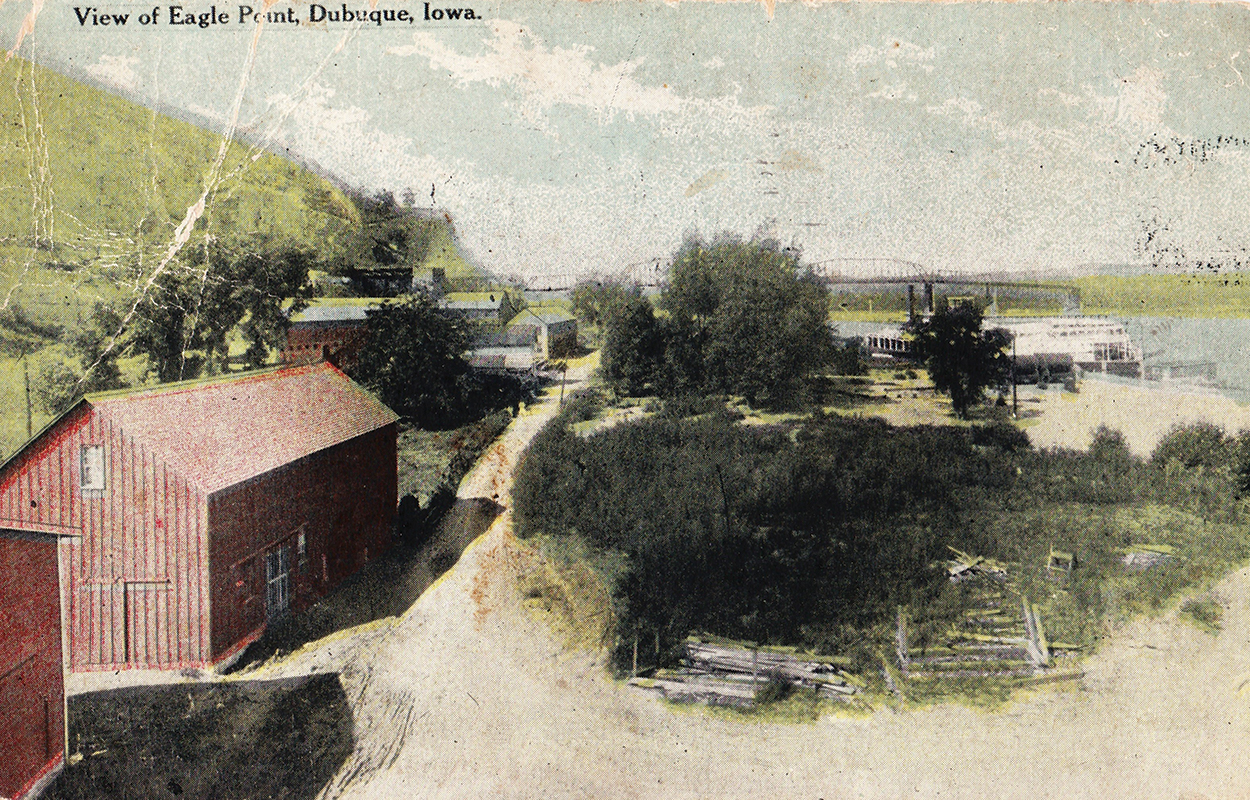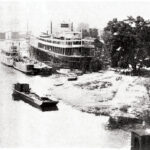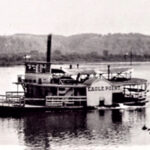When most people hear the name Eagle Point, they think of Dubuque’s beautiful park high on the bluff above the Mississippi River. But back in the 1800s and into the early 1900s, Eagle Point was a bustling little community nestled along the banks of the river, below the park with the same name.
The town of Eagle Point was established in 1837 by Mathias Ham, Thomas McCraney, F.K. O’Ferrall, and John Foley. A June 17, 1837 advertisement in the Iowa News touted the sale of lots in Eagle Point: This town … is delightfully situated on the west bank of the Mississippi River, about one mile north of … Dubuque. The commercial advantages of this town as well as its proximity to the rich mineral and agricultural country back of it, need not be enumerated to those acquainted with the situation. Its central position and commanding location will at once be observed by a slight reference to the map of the Territory. The steamboat landing is inferior to none from St. Louis to St. Peters. No town in the far west can boast of a more healthy location – springs of the best and purest of water are found in abundance gushing out from the cliff at the rear of the town. Eagle Point was also the site of many businesses, including the Diamond Jo Boatyard, Eagle Point Ferry, Eagle Point Lime Works, and Eagle Point Swimming Beach.
Diamond Jo Boatyard
In 1878, Joseph “Diamond Jo” Reynolds relocated his Diamond Jo Line of river steamers to Eagle Point, where he also founded a boatyard. The Diamond Jo Boatyard specialized in building and repairing wooden-hulled steamers – not just for the Diamond Jo Line, but also for boats belonging to other Mississippi River riverboat operators. At its peak, the company employed some 100 workers and created a huge demand for lumber, hardware, and iron work.
The Diamond Jo Line was sold to the Streckfus Company of Rock Island in 1911. Streckfus also received Diamond Jo steamers, wharves, warehouses, and boatyards as part of the sale. The boatyard at Eagle Point was soon abandoned.
Eagle Point Ferry
The exact date of the first ferry located at Eagle Point is unknown, but a ferry was in operation by April 1852. At that time, the cost for a loaded wagon with a pair of horses and a driver from the east side of the river to Eagle Point was 50¢, with each additional pair of horses or oxen adding 25¢ to the bill. In 1870, the J.A. Rhomberg was built to serve as a ferryboat, providing a convenient method of travel between Eagle Point and Wisconsin.
In August 1883, the Dubuque City Council approved a 25-year license, giving a group of local men permission to operate a Mississippi River ferry known as the “Eagle Point, Dubuque, and Grant County [Wisconsin] Ferry.” In 1894, the J.A. Rhomberg was replaced by the “side-wheeler” Eagle Point, which burned at Dubuque in June 1894. Ultimately, the construction of bridges across the river doomed the ferry business.
Eagle Point Lime Works and Quarry
George Fengler founded the Eagle Point Lime Works in 1872, and in 1875 sold half his interest in the company to Henry Kriete. Located below the limestone bluff at Eagle Point, the production of wood-burnt lime from heated limestone totaled some 350 barrels daily during peak operation. The company ran without competition through 1910.
Lime was used in the manufacture of mortar, plaster, and whitewash as well as for tanning hides, agriculture, and sanitation. The lime produced by the Eagle Point plant was prized not only for its hardness, but also its white color that intensified over time. Eagle Point lime was shipped to Michigan, Minnesota, Wisconsin, and Illinois.
Eagle Point Lime Works also carried fire brick, building brick, plastering hair, cement, and stucco, along with various sizes of crushed rock used for wagon roads, city streets and buildings, and railroad track beds. In 1922, the company supplied the brick and rock for 150 Dubuque homes. Eagle Point materials were used in the construction of two junior high schools and Dubuque Senior High School.
Dubuque Stone Products Company acquired the rock quarry in 1926. In 1963, the site became the location of Eagle Point Fun Land.
Eagle Point Beach
Eagle Point Beach was “unofficially” established in 1912, although swimmers had been using the Mississippi River beach for decades. James Gould was the caretaker and he also rented out swimsuits. Two tents, divided into smaller dressing rooms, were available to swimmers who flocked to the sandy beach and diving tower north of the City Water Works building.
The cost of maintaining the beach as the river rose and fell caused the city’s Bathing Beach Commission to declare the beach “closed” in 1915. This did not stop swimmers, so the city was forced to reopen the popular attraction. On August 19, 1916, the city-run beach officially opened to a crowd of some 3,000.Later, the American Red Cross offered swim lessons, lifeguards were hired, a high diving platform was erected, and an “ocean-wave contrivance” consisting of a 30-foot chute made the beach even more appealing. In 1936, the swimming beach closed for good. However, a new municipal pool opened the next year.
The passage of time and opening of Lock and Dam No. 11 in 1937 have erased almost all traces of the community of Eagle Point. Only the quarry remains as a silent reminder of what once was a vibrant site of work and leisure.
This article is part of the Shades of Dubuque series, sponsored by Trappist Caskets, hand-made and blessed by the monks at New Melleray Abbey.









Comment here